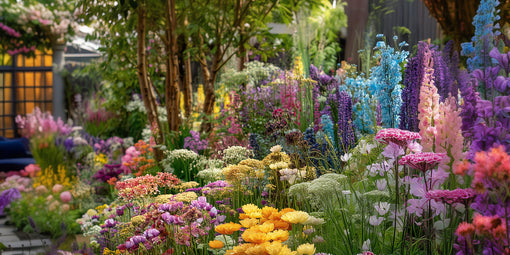
- Article published at:
Drawer menu

Today, we're diving into the world of Scabiosa flowers. Have you ever come across these beauties and wondered about their story? Well, we're here to spill the tea on everything Scabiosa! From its physical characteristics to its symbolic flower meanings, growing tips to various uses - we've got it all covered in this post.
We are particularly drawn to Scabiosa's delicate yet bold appearance. But it's not just about the looks - this flower is full of surprises! So, grab your gardening gloves and let's get ready to explore the wonderful world of Scabiosa together.


Let's talk about Scabiosa's physical appearance, shall we? Picture this: a fluffy, round head that's packed with frilly petals. The petals themselves come in a range of hues, from pastel pinks to deep purples, and even striking shades of blue.
And can we talk about the stamens? They protrude proudly, creating a unique texture that sets the Scabiosa apart from other flowers. But wait, there's more! Scabiosa also boasts slender stems that can grow up to 2 feet in height, making it a statement piece in any garden or bouquet.
Whether you're a fan of dainty details or bold and beautiful blooms, Scabiosa's got you covered! The Scabiosa is getting more and more popular among us florists to include in weddings and event.
We especially love them since they bring a certain whimsical feel to an arrangement and they "dance" in a very graceful yet quirky way.

Beyond its eye-catching appearance, the Scabiosa also carries a lot of symbolism and meaning. Traditionally, this flower represents purity and innocence - a perfect gift for a loved one or a sweet addition to a wedding bouquet.
But that's not all! In ancient times, Scabiosa was believed to have healing powers and was used to treat various ailments. Talk about a multi-talented flower! Nowadays, the Scabiosa has taken on new meanings, often associated with strength and overcoming adversity.
It's a reminder that even the most delicate things can have a powerful impact.

So how do you grow your own Scabiosa flowers? Firstly, make sure you plant them in well-draining soil with plenty of sunlight. These flowers don't like their feet to be wet, so don't over-water them.
Another tip - sow the seeds directly into the ground as opposed to starting them indoors. Not only does this save time and effort, but it also ensures a better survival rate.
And guess what? Scabiosa is a self-seeding flower, so you'll have beautiful blooms year after year without lifting a finger. Just sit back and let Mother Nature work her magic! With a little TLC, your Scabiosa will thrive and become the star of your garden.

Finally, let's chat about the many uses of Scabiosa flowers. From weddings to culinary creations, this flower can do it all! Its striking appearance makes it a popular choice for wedding bouquets and centrepieces, adding a touch of elegance and sophistication to any celebration.
But that's not all - did you know that Scabiosa is also used in the culinary world? Its petals can be added to salads, drinks, and even desserts for a pop of colour and flavour.
And let's not forget about its medicinal properties - Scabiosa has been used for centuries to treat various ailments such as headaches, digestive issues, and even fevers. Who knew a flower could be so versatile? With so many uses, the Scabiosa is truly a gem in the floral world.
Well, folks, that's a wrap on our Scabiosa flower adventure! From its fluffy petals to its symbolic meanings, growing tips to various uses, we've covered it all. We hope this post has inspired you to add a touch of Scabiosa to your life - whether it's through planting them in your garden, incorporating them into your cooking, or simply appreciating their beauty.
One thing is for sure - Scabiosa is more than just a pretty face. It's a flower that carries a rich history, a powerful message, and a multitude of uses. So, the next time you come across a Scabiosa, take a moment to appreciate all that it represents. Until next time, happy gardening!
What's your favourite thing about Scabiosa flowers? Pop a comment in the field below and let us know!